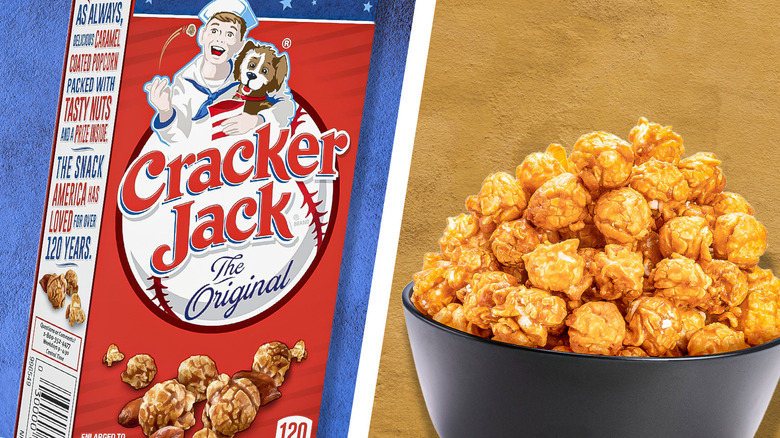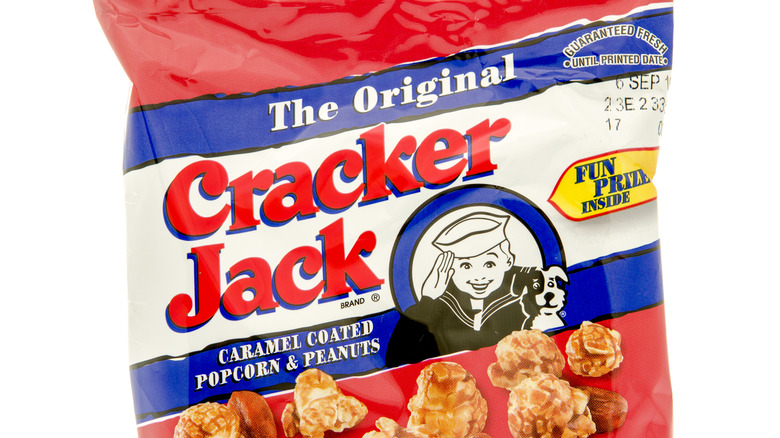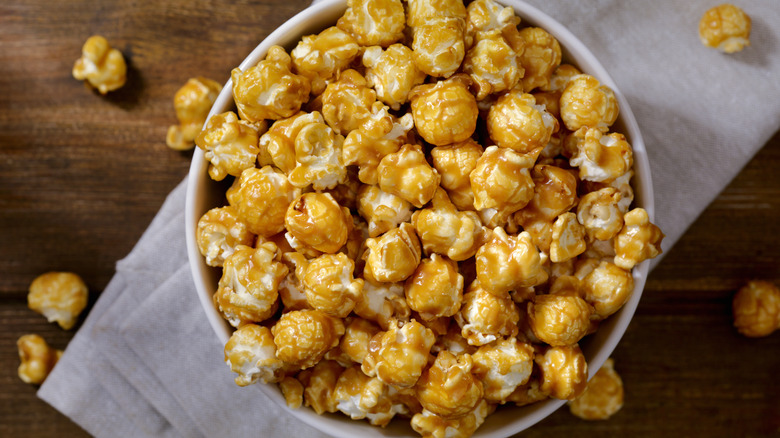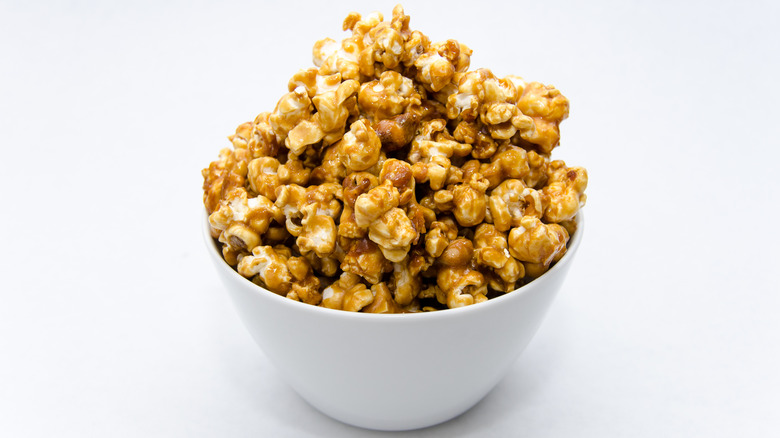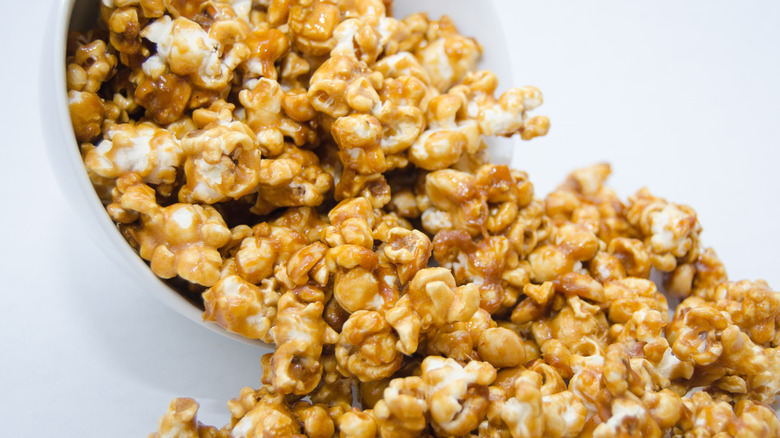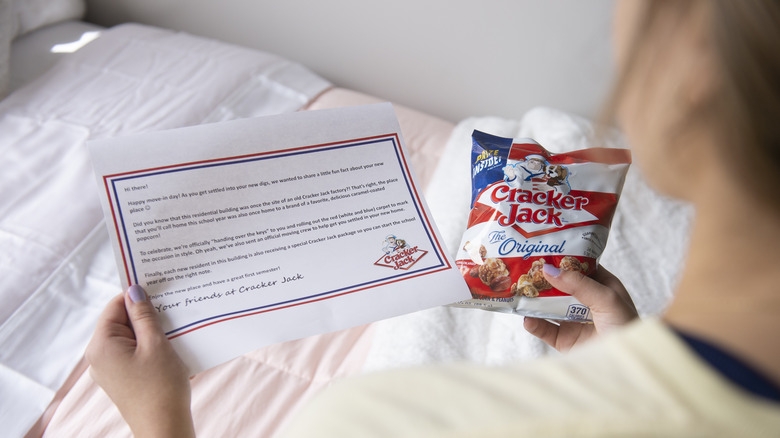Cracker Jack Vs Caramel Corn: What's The Difference?
The most tempting snacks offer a dangerous combination of satisfying texture and can't-quite-put-it-down flavor. Salty, buttery popcorn covered in sweet caramel is a tough one to beat when it comes to this kind of a one-two punch of a recipe. Whether sitting at a movie theater or watching a baseball game, handfuls of these sweet, toothy bites make for irresistible mouthfuls that equal both mindless enjoyment and easy comfort.
Though confusing Cracker Jack popcorn and caramel popcorn is a forgivable mistake for the uninitiated, we're here to make distinctions clear when it comes to these two snackable recipes. Armed with the knowledge of what makes bags of Cracker Jack unique when compared to a bowl of caramel popcorn, you will be able to make confident choices the next time you attempt to pop kernels on the stove to silence loud rumblings of hunger with your own homemade recipes. Plus, if you have peanut allergies to consider, you may want to know what you're getting yourself into.
What is Cracker Jack?
Unveiled in 1893, Cracker Jack made its first appearance at the Chicago World Fair. Brothers F.W. and Louis Rueckheim added peanuts to popcorn and made a molasses-based recipe that wasn't sticky. The German brothers' experimentations with popcorn recipes began much earlier than the launch of Cracker Jack, however, as the duo had been whipping up popcorn flavors and various toppings out of their own popcorn business as early as 1870.
The tempting combination of peanuts, popcorn, and molasses was a quick hit with their customers, one of whom exclaimed "That's a crackerjack!" upon sampling the original flavor. At the time, crackerjack was a term used to describe something great, and the declaration stuck to the treat as fast as palates started to crave the snack. The success of the culinary invention led to the registration of the snack in 1896 and the subsequent popularization of caramel-topped nuts and popcorn.
What is caramel corn?
Though caramel corn lacks the inclusion of peanuts and molasses, the sweet treat still makes for an enjoyable treat. Covered in a delicious layer of caramel, these crunchy puffed pieces of popcorn have been enjoyed since the 1800s. The easy-to-munch-on snack can be made to suit individual palates, with the added inclusion of brown sugar or extra butter or salt to ensure every craving is properly addressed.
Though caramel corn was first introduced to the masses in the 1870s, sweetened popcorn was enjoyed many years before. Kettle corn made with oil, sugar, and salt made frequent appearances during holidays, fairs, and special occasions. Once the popcorn maker was invented, the ease at which popcorn could be found at various celebrations popped as quickly as a corn kernel, resulting in the sweet-and-salty treat acquiring a holiday of its own — National Caramel Popcorn Day, which is held on April 6.
The inclusion of nuts
One of the key differences between packages of Cracker Jack and bowls filled with caramel popcorn is the addition of nuts that offer extra crunch to the branded snack. Cracker Jack delivers the flavor combination of salty, earthy peanuts matched with the sweetness of caramel popcorn, while caramel popcorn itself can pack a sweeter punch without the pop of shelled nuts. For those wanting the inclusion of peanuts, Cracker Jack snack mix is the way to go. However, for eaters with peanut allergies or those who crave nut-free bites of caramelized popcorn, a simple serving of caramel popcorn can do the trick.
Though, upon first glance, the addition of peanuts in the Cracker Jack mixture appears to be the primary differentiating factor between the two snacks, more than meets the eye when it comes to the flavors of Cracker Jack and caramel popcorn. While snack munchers may have peanuts on their minds, there's another deciding factor when determining which is the best treat to reach for as hunger strikes.
A special sweetener
While the added peanuts are the most noticeable difference between the two snacks, these candy-coated pieces have different ingredients to lend their sweet flavors. While a handful of caramel corn delivers bites of popcorn coated with caramel, Cracker Jack popcorn has molasses added to its secret recipe. This special taste prompted the catchy tagline "The More You Eat, The More You Want," and the slogan was registered in 1896.
When Cracker Jack mix was first introduced to the public, the brothers received complaints about the sticky residue left behind on their fingertips. The determined duo revised their recipe to result in a coasting that was dry and crunchy yet still delivered the sweetness found in the original creation. Not only were customers' palms protected from a caramel mess, but the popcorn pieces themselves didn't clump together. Since Cracker Jack was packaged and sold in large containers until the 1899 invention of wax-sealed packages, the brothers' special ingredients made a difference for those eager to dig in to sample the crunchy snack.
Marketing and pop culture
Flavor and ingredients aren't all that separate packages of Cracker Jack from simple servings of caramel popcorn. Since 1912, snack eaters have found toys added to Cracker Jack snacks. From small plastic animals to stickers and temporary tattoos, these hidden prizes increased sales for the brand.
If the added incentive of finding a hidden prize inside of a snack package wasn't enough, an earworm of a jingle helped cement Cracker Jack into the minds, hearts, and stomachs of Americans. Take Me Out to the Ball Game, written in 1908, can still be heard at baseball games today, and the catchy tune inspired the company to insert baseball cards into the packages — some of the cards which now have amassed value in the several thousands. Though tiny rings and booklets have been replaced by codes that are meant to be used in an online arcade, the memory of digging into a popcorn mix to find a prize lives on for many lovers of Cracker Jack. We suppose this experience, too, could be replicated at home with a bit of creative ingenuity.
